We sequenced the mitochondrial genome of the Western inexperienced lizard (Lacerta bilineata) utilizing Illumina know-how and extra Sanger sequencing. The assembled 17 086 bp mitogenome had a GC content material of 40.32% and consisted of 13 protein-coding genes, 22 tRNA genes, two rRNA genes, and one management area (CR), with a gene order similar to the chordate consensus. As well as, we re-sequenced the mitogenome of the intently associated Jap inexperienced lizard L. viridis utilizing the identical methods as for L. bilineata.
The mitogenomes of L. bilineata and L. viridis confirmed a sequence identification of 94.4% and 99.9%, respectively, relative to the beforehand revealed L. viridis mitogenome. The phylogenetic reconstruction primarily based on 17 Lacertinae mitogenomes utilizing Anolis carolinensis because the outgroup supported L. bilineata and its sister species L. viridis as distinct lineages. On this examine, the expression of genes coding for α-, β- and γ-syns was analyzed within the inexperienced lizard Anolis carolinensis by semiquantitative RT-PCR and Western blot.
The synuclein (syn) household includes three proteins: α-, β- and γ-syns. In people, they’re concerned in neurodegenerative ailments equivalent to Parkinson’s illness and in tumors. Members of the syn household had been sequenced in consultant species of all vertebrates and the comparative evaluation of amino acid sequences means that syns are evolutionarily conserved, however details about their expression in vertebrate lineages remains to be scarce and fully missing in reptiles. Outcomes show good expression ranges of the three syns within the lizard nervous system, equally to human syns. This, along with the excessive identification between lizard and human syns, means that these proteins fulfill evolutionarily conserved features.
Accumulation of transposable components in Hox gene clusters throughout adaptive radiation of Anolis lizards.
Transposable components (TEs) are DNA sequences that may insert elsewhere within the genome and modify genome construction and gene regulation. The function of TEs in evolution is contentious. One speculation posits that TE exercise generates genomic incompatibilities that may trigger reproductive isolation between incipient species. This predicts that TEs will accumulate throughout speciation occasions. Right here, I examined the prediction that extant lineages with a comparatively excessive price of speciation have a excessive variety of TEs of their genomes.
I sequenced and analysed the TE content material of a marker genomic area (Hox clusters) in Anolis lizards, a basic case of an adaptive radiation. Not like different vertebrates, together with intently associated lizards, Anolis lizards have excessive numbers of TEs of their Hox clusters, genomic areas that regulate growth of the morphological variations that characterize habitat specialists in these lizards. Following a burst of TE exercise within the lineage resulting in extant Anolis, TEs have continued to build up throughout or after speciation occasions, leading to a constructive relationship between TE density and lineage speciation price. These outcomes are according to the prediction that TE exercise contributes to adaptive radiation by selling speciation.
Though there was no proof that TE density per se is related to ecological morphology, the exercise of TEs in Hox clusters may have been a wealthy supply for phenotypic variation which will have facilitated the fast parallel morphological adaptation to microhabitats seen in extant Anolis lizards. The MALAT1 (Metastasis-Related Lung Adenocarcinoma Transcript 1) gene encodes a noncoding RNA that’s processed into a protracted nuclear retained transcript (MALAT1) and a small cytoplasmic tRNA-like transcript (mascRNA).
Utilizing an RNA sequence– and structure-based covariance mannequin, we recognized greater than 130 genomic loci in vertebrate genomes containing the MALAT1 3′ finish triple-helix construction and its quick downstream tRNA-like construction, together with 44 within the inexperienced lizard Anolis carolinensis. Structural and computational analyses revealed a co-occurrence of parts of the three’ finish module. MALAT1-like genes in Anolis carolinensis are extremely expressed in grownup testis, thus we named them testis-abundant lengthy noncoding RNAs (tancRNAs). These findings recommend that differential regulation of microRNAs might play a task in coordinating the timing and expression of tons of of genes concerned in regeneration.

Differential expression of conserved and novel microRNAs throughout tail regeneration within the lizard Anolis carolinensis.
Lizards are evolutionarily probably the most intently associated vertebrates to people that may lose and regrow a complete appendage. Regeneration in lizards includes differential expression of tons of of genes that regulate wound therapeutic, musculoskeletal growth, hormonal response, and embryonic morphogenesis. Whereas microRNAs are in a position to regulate massive teams of genes, their function in lizard regeneration has not been investigated. MicroRNA sequencing of inexperienced anole lizard (Anolis carolinensis) regenerating tail and related tissues revealed 350 putative novel and 196 recognized microRNA precursors.
 [HRP] Antibody) Anti- Goat Anti Rabbit IgG (HL) [HRP] Antibody |
|
GWB-5A4353 |
GenWay Biotech |
1 mg |
Ask for price |
 (Fc)) IgG Antibody (Rabbit anti Goat) (Fc) |
|
GWB-51506C |
GenWay Biotech |
1 ml |
Ask for price |
|
|
 (Fc)) IgG Antibody (Rabbit anti Goat) (Fc) |
|
GWB-7BB68B |
GenWay Biotech |
1 ml |
Ask for price |
 (Fc)) IgG Antibody (Rabbit anti Goat) (Fc) |
|
GWB-CBDFE9 |
GenWay Biotech |
1.5 ml |
Ask for price |
 (H&L)) IgG Antibody (Goat anti Rabbit) (H&L) |
|
GWB-39B790 |
GenWay Biotech |
2 mg |
Ask for price |
|
|
 (H&L)) IgG Antibody (Goat anti Rabbit) (H&L) |
|
GWB-3F03E0 |
GenWay Biotech |
2 mg |
Ask for price |
|
|
 (H&L)) IgG Antibody (Goat anti Rabbit) (H&L) |
|
GWB-423B57 |
GenWay Biotech |
1 ml |
Ask for price |
|
|
 (H&L)) IgG Antibody (Goat anti Rabbit) (H&L) |
|
GWB-4BF9D8 |
GenWay Biotech |
10 mg |
Ask for price |
|
|
 (H&L)) IgG Antibody (Goat anti Rabbit) (H&L) |
|
GWB-5F513F |
GenWay Biotech |
1 mg |
Ask for price |
 (H&L)) IgG Antibody (Goat anti Rabbit) (H&L) |
|
GWB-233373 |
GenWay Biotech |
1.5 ml |
Ask for price |
|
|
 (H&L)) IgG Antibody (Goat anti Rabbit) (H&L) |
|
GWB-10D6B2 |
GenWay Biotech |
2 ml |
Ask for price |
|
|
 (H&L)) IgG Antibody (Goat anti Rabbit) (H&L) |
|
GWB-1CDFA2 |
GenWay Biotech |
0.5 mg |
Ask for price |
|
|
 (H&L)) IgG Antibody (Goat anti Rabbit) (H&L) |
|
GWB-AB00ED |
GenWay Biotech |
2 ml |
Ask for price |
 (H&L)) IgG Antibody (Goat anti Rabbit) (H&L) |
|
GWB-AC3EDA |
GenWay Biotech |
5 mg |
Ask for price |
 (H&L)) IgG Antibody (Goat anti Rabbit) (H&L) |
|
GWB-74EC69 |
GenWay Biotech |
2 mg |
Ask for price |
 Rabbit Anti-Sheep/Goat IgG antibody |
|
STJ99581-100l |
St John's Laboratory |
100 µl |
EUR 104.4 |
|
Description: Unconjugated Rabbit monoclonal to Sheep/Goat IgG antibody |
 Rabbit Anti-Sheep/Goat IgG antibody |
|
STJ99581-1mL |
St John's Laboratory |
1 mL |
EUR 546 |
|
Description: Unconjugated Rabbit monoclonal to Sheep/Goat IgG antibody |
 (H&L)) IgG Antibody (Rabbit anti Goat) (H&L) |
|
GWB-681D85 |
GenWay Biotech |
2 mg |
Ask for price |
 (H&L)) IgG Antibody (Rabbit anti Goat) (H&L) |
|
GWB-AFFF41 |
GenWay Biotech |
1.5 mg |
Ask for price |
 F(ab )2) IgG Antibody (Goat anti Rabbit) F(ab )2 |
|
GWB-6B86BE |
GenWay Biotech |
2 ml |
Ask for price |
 Goat anti Rabbit IgG |
|
41C-CB1143 |
Fitzgerald |
2 mg |
EUR 259 |
|
|
|
Description: Goat anti Rabbit IgG secondary antibody |
 Goat anti Rabbit IgG |
|
41C-CB1150 |
Fitzgerald |
10 mg |
EUR 985 |
|
|
|
Description: Goat anti Rabbit IgG secondary antibody |
 Goat anti Rabbit IgG |
|
41R-1079 |
Fitzgerald |
2 mg |
EUR 127 |
|
|
|
Description: Goat anti Rabbit IgG secondary antibody |
 Goat anti Rabbit IgG |
|
40C-CB1157 |
Fitzgerald |
5 mg |
Ask for price |
|
|
|
Description: Goat anti Rabbit IgG secondary antibody |
 Goat anti Rabbit IgG |
|
41-GR30 |
Fitzgerald |
10 mg |
EUR 229 |
|
|
|
Description: Goat anti Rabbit IgG secondary antibody |
 Goat anti Rabbit IgG |
|
41-GR31 |
Fitzgerald |
5 mg |
EUR 194.4 |
|
Description: Goat anti Rabbit IgG secondary antibody |
 Goat anti Rabbit IgG |
|
40-GR30 |
Fitzgerald |
100 ml |
EUR 332 |
|
|
|
Description: Goat anti Rabbit IgG secondary antibody |
 Goat anti Rabbit IgG |
|
40-GR30S |
Fitzgerald |
100 ml |
EUR 95 |
|
|
|
Description: Goat anti Rabbit IgG secondary antibody |
 goat Anti Rabbit IgG |
|
E61I01301 |
EnoGene |
1mg |
EUR 172.5 |
 goat Anti Rabbit IgG |
|
MBS8503153-1mg |
MyBiosource |
1mg |
EUR 255 |
 goat Anti Rabbit IgG |
|
MBS8503153-5x1mg |
MyBiosource |
5x1mg |
EUR 1000 |
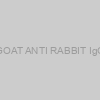 GOAT ANTI RABBIT IgG |
|
MBS235217-1mg |
MyBiosource |
1mg |
EUR 245 |
 GOAT ANTI RABBIT IgG |
|
MBS235217-5x1mg |
MyBiosource |
5x1mg |
EUR 925 |
 Goat anti Rabbit IgG |
|
MBS539091-INQUIRE |
MyBiosource |
INQUIRE |
Ask for price |
 Goat anti Rabbit IgG |
|
MBS539100-100mL |
MyBiosource |
100mL |
EUR 870 |
 Goat anti Rabbit IgG |
|
MBS539100-5x100mL |
MyBiosource |
5x100mL |
EUR 3760 |
 Goat anti Rabbit IgG |
|
MBS539169-10mg |
MyBiosource |
10mg |
EUR 605 |
 Goat anti Rabbit IgG |
|
MBS539169-5x10mg |
MyBiosource |
5x10mg |
EUR 2570 |
 Goat anti Rabbit IgG |
|
MBS539780-10mg |
MyBiosource |
10mg |
EUR 1695 |
 Goat anti Rabbit IgG |
|
MBS539780-5x10mg |
MyBiosource |
5x10mg |
EUR 7465 |
 Goat anti Rabbit IgG |
|
MBS539800-2mg |
MyBiosource |
2mg |
EUR 480 |
 Goat anti Rabbit IgG |
|
MBS539800-5x2mg |
MyBiosource |
5x2mg |
EUR 2005 |
 (Frag Specific)) Goat anti Rabbit IgG Antibody (Fc) (Frag Specific) |
|
GWB-5B2214 |
GenWay Biotech |
1.5 ml |
Ask for price |
 Rabbit anti Goat IgG |
|
20-S5801R000-VO |
Fitzgerald |
10 ml |
EUR 95 |
|
|
|
Description: Rabbit anti Goat IgG antibody |
 Rabbit anti Goat IgG |
|
41C-CB0529 |
Fitzgerald |
2 mg |
EUR 234 |
|
|
|
Description: Rabbit anti Goat IgG secondary antibody |
 Rabbit anti Goat IgG |
|
40C-CB0536 |
Fitzgerald |
1.5 mg |
EUR 274 |
|
|
|
Description: Rabbit anti Goat IgG secondary antibody |
 Rabbit anti Goat IgG |
|
E61I01002 |
EnoGene |
1mg |
EUR 225 |
 Rabbit anti Goat IgG |
|
MBS539774-2mg |
MyBiosource |
2mg |
EUR 435 |
 Rabbit anti Goat IgG |
|
MBS539774-5x2mg |
MyBiosource |
5x2mg |
EUR 1815 |
 Antibody) Rabbit Anti-Sheep / Goat IgG (H&L) Antibody |
|
20-abx134906 |
Abbexa |
-
Ask for price
-
Ask for price
|
|
|
|
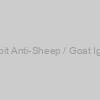 Rabbit Anti-Sheep / Goat IgG H&L Antibody |
|
abx134906-01mg |
Abbexa |
0.1 mg |
EUR 187.5 |
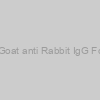 Goat anti Rabbit IgG Fc |
|
41C-CB1136 |
Fitzgerald |
2 mg |
EUR 234 |
|
|
|
Description: Goat anti Rabbit IgG secondary antibody |
 Goat anti Rabbit IgG Fc |
|
70R-IG011 |
Fitzgerald |
1.5 mg |
EUR 348 |
|
|
|
Description: Goat anti Rabbit IgG Fc secondary antibody |
 Goat anti Rabbit IgG Fc |
|
70R-IG017 |
Fitzgerald |
2 mg |
EUR 347 |
|
|
|
Description: Goat anti Rabbit IgG Fc secondary antibody |
) GOAT ANTI RABBIT IgG (Fc) |
|
MBS235249-1mg |
MyBiosource |
1mg |
EUR 265 |
) GOAT ANTI RABBIT IgG (Fc) |
|
MBS235249-5x1mg |
MyBiosource |
5x1mg |
EUR 1020 |
) Goat anti Rabbit IgG (Fc) |
|
MBS316567-2mL |
MyBiosource |
2mL |
EUR 590 |
) Goat anti Rabbit IgG (Fc) |
|
MBS316567-5x2mL |
MyBiosource |
5x2mL |
EUR 2485 |
) Goat anti Rabbit IgG (Fc) |
|
MBS316619-2mg |
MyBiosource |
2mg |
EUR 295 |
) Goat anti Rabbit IgG (Fc) |
|
MBS316619-5x2mg |
MyBiosource |
5x2mg |
EUR 1150 |
 Goat anti Rabbit IgG Fc |
|
MBS539776-2mg |
MyBiosource |
2mg |
EUR 435 |
 Goat anti Rabbit IgG Fc |
|
MBS539776-5x2mg |
MyBiosource |
5x2mg |
EUR 1815 |
 Goat anti Rabbit IgG Fc |
|
MBS534059-2mg |
MyBiosource |
2mg |
EUR 485 |
 Goat anti Rabbit IgG Fc |
|
MBS534059-5x2mg |
MyBiosource |
5x2mg |
EUR 2030 |
 Goat anti Rabbit IgG Fc |
|
MBS535045-15mg |
MyBiosource |
1.5mg |
EUR 490 |
 Goat anti Rabbit IgG Fc |
|
MBS535045-5x15mg |
MyBiosource |
5x1.5mg |
EUR 2055 |
) Goat anti Rabbit IgG (HRP) |
|
43C-CB1141 |
Fitzgerald |
2 mg |
EUR 397 |
|
|
|
Description: Goat anti Rabbit IgG secondary antibody (HRP) |
) Goat anti Rabbit IgG (HRP) |
|
43C-CB1148 |
Fitzgerald |
2 mg |
EUR 353 |
|
|
|
Description: Goat anti Rabbit IgG secondary antibody (HRP) |
) Goat anti Rabbit IgG (HRP) |
|
43C-CB1155 |
Fitzgerald |
2 mg |
EUR 344 |
|
|
|
Description: Goat anti Rabbit IgG secondary antibody (HRP) |
) Goat anti Rabbit IgG (HRP) |
|
43C-CB1162 |
Fitzgerald |
2 mg |
EUR 376 |
|
|
|
Description: Goat anti Rabbit IgG secondary antibody (HRP) |
) Goat anti Rabbit IgG (HRP) |
|
43R-1495 |
Fitzgerald |
1 mg |
EUR 115 |
|
|
|
Description: Goat anti Rabbit IgG secondary antibody (HRP) |
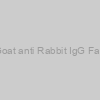 Goat anti Rabbit IgG Fab |
|
MBS573197-1mL |
MyBiosource |
1mL |
EUR 365 |
 Goat anti Rabbit IgG Fab |
|
MBS573197-5x1mL |
MyBiosource |
5x1mL |
EUR 1490 |
) Goat anti Rabbit IgG (HRP) |
|
MBS538611-2mg |
MyBiosource |
2mg |
EUR 620 |
) Goat anti Rabbit IgG (HRP) |
|
MBS538611-5x2mg |
MyBiosource |
5x2mg |
EUR 2635 |
) Goat anti Rabbit IgG (HRP) |
|
MBS538619-2mg |
MyBiosource |
2mg |
EUR 655 |
) Goat anti Rabbit IgG (HRP) |
|
MBS538619-5x2mg |
MyBiosource |
5x2mg |
EUR 2805 |
) Goat anti Rabbit IgG (HRP) |
|
MBS539812-2mg |
MyBiosource |
2mg |
EUR 595 |
) Goat anti Rabbit IgG (HRP) |
|
MBS539812-5x2mg |
MyBiosource |
5x2mg |
EUR 2515 |
) Goat anti Rabbit IgG (HRP) |
|
MBS539843-2mg |
MyBiosource |
2mg |
EUR 715 |
) Goat anti Rabbit IgG (HRP) |
|
MBS539843-5x2mg |
MyBiosource |
5x2mg |
EUR 3075 |
) Goat anti Rabbit IgG (FITC) |
|
43C-CB1137 |
Fitzgerald |
2 mg |
EUR 256 |
|
|
|
Description: Goat anti Rabbit IgG secondary antibody (FITC) |
) Goat anti Rabbit IgG (FITC) |
|
43C-CB1144 |
Fitzgerald |
2 mg |
EUR 293 |
|
|
|
Description: Goat anti Rabbit IgG secondary antibody (FITC) |
) Goat anti Rabbit IgG (FITC) |
|
43C-CB1158 |
Fitzgerald |
2 mg |
EUR 418 |
|
|
|
Description: Goat anti Rabbit IgG secondary antibody (FITC) |
) Goat anti Rabbit IgG (FITC) |
|
43R-1494 |
Fitzgerald |
2 mg |
EUR 176 |
|
|
|
Description: Goat anti Rabbit IgG secondary antibody (FITC) |
) Goat anti Rabbit IgG (FITC) |
|
43-GR59 |
Fitzgerald |
2 mg |
EUR 276 |
|
|
|
Description: Goat anti Rabbit IgG secondary antibody (FITC) |
) Goat anti Rabbit IgG (FITC) |
|
MBS538607-2mg |
MyBiosource |
2mg |
EUR 540 |
) Goat anti Rabbit IgG (FITC) |
|
MBS538607-5x2mg |
MyBiosource |
5x2mg |
EUR 2280 |
) Goat anti Rabbit IgG (FITC) |
|
MBS538616-2mg |
MyBiosource |
2mg |
EUR 750 |
) Goat anti Rabbit IgG (FITC) |
|
MBS538616-5x2mg |
MyBiosource |
5x2mg |
EUR 3230 |
) Goat anti Rabbit IgG (FITC) |
|
MBS539784-2mg |
MyBiosource |
2mg |
EUR 480 |
) Goat anti Rabbit IgG (FITC) |
|
MBS539784-5x2mg |
MyBiosource |
5x2mg |
EUR 2005 |
) Goat anti Rabbit IgG (FITC) |
|
MBS539825-2mg |
MyBiosource |
2mg |
EUR 500 |
) Goat anti Rabbit IgG (FITC) |
|
MBS539825-5x2mg |
MyBiosource |
5x2mg |
EUR 2105 |
 goat Anti Rabbit IgG-HRP |
|
E61I01303 |
EnoGene |
1mg |
EUR 345 |
) Goat anti Rabbit IgG (biotin) |
|
43C-CB1140 |
Fitzgerald |
2 mg |
EUR 297 |
|
|
|
Description: Goat anti Rabbit IgG secondary antibody (biotin) |
) Goat anti Rabbit IgG (biotin) |
|
43C-CB1147 |
Fitzgerald |
2 mg |
EUR 373 |
|
|
|
Description: Goat anti Rabbit IgG secondary antibody (biotin) |
) Goat anti Rabbit IgG (biotin) |
|
43C-CB1154 |
Fitzgerald |
2 mg |
EUR 297 |
|
|
|
Description: Goat anti Rabbit IgG secondary antibody (biotin) |
) Goat anti Rabbit IgG (biotin) |
|
43C-CB1161 |
Fitzgerald |
2 mg |
EUR 376 |
|
|
|
Description: Goat anti Rabbit IgG secondary antibody (biotin) |
) Goat anti Rabbit IgG (biotin) |
|
43R-1493 |
Fitzgerald |
2 mg |
EUR 167 |
|
|
|
Description: Goat anti Rabbit IgG secondary antibody (biotin) |
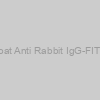 goat Anti Rabbit IgG-FITC |
|
E61I01304 |
EnoGene |
1mg |
EUR 431.25 |
 goat Anti Rabbit IgG-FITC |
|
MBS8502220-1mg |
MyBiosource |
1mg |
EUR 510 |
 goat Anti Rabbit IgG-FITC |
|
MBS8502220-5x1mg |
MyBiosource |
5x1mg |
EUR 2140 |
) Goat anti Rabbit IgG (biotin) |
|
MBS538610-2mg |
MyBiosource |
2mg |
EUR 655 |
) Goat anti Rabbit IgG (biotin) |
|
MBS538610-5x2mg |
MyBiosource |
5x2mg |
EUR 2805 |
) Goat anti Rabbit IgG (biotin) |
|
MBS538618-2mg |
MyBiosource |
2mg |
EUR 655 |
) Goat anti Rabbit IgG (biotin) |
|
MBS538618-5x2mg |
MyBiosource |
5x2mg |
EUR 2805 |
) Goat anti Rabbit IgG (biotin) |
|
MBS539045-2mg |
MyBiosource |
2mg |
EUR 540 |
) Goat anti Rabbit IgG (biotin) |
|
MBS539045-5x2mg |
MyBiosource |
5x2mg |
EUR 2280 |
) Goat anti Rabbit IgG (biotin) |
|
MBS539773-2mg |
MyBiosource |
2mg |
EUR 540 |
) Goat anti Rabbit IgG (biotin) |
|
MBS539773-5x2mg |
MyBiosource |
5x2mg |
EUR 2280 |
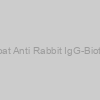 goat Anti Rabbit IgG-Biotin |
|
E61I01302 |
EnoGene |
1mg |
EUR 345 |
Eleven microRNAs had been differentially expressed between the regenerating tail tip and base throughout most outgrowth (25 days publish autotomy), together with miR-133a, miR-133b, and miR-206, which have been reported to manage regeneration and stem cell proliferation in different mannequin programs. Three putative novel differentially expressed microRNAs had been recognized within the regenerating tail tip. Differentially expressed microRNAs had been recognized within the regenerating lizard tail, together with recognized regulators of stem cell proliferation. The identification of three putative novel microRNAs means that regulatory networks, both conserved in vertebrates and beforehand uncharacterized or particular to lizards, are concerned in regeneration.


